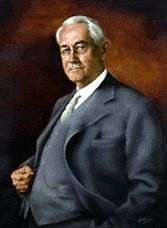Lamartine Griffin Hardman
Lamartine Griffin Hardman (April 14, 1856 – February 18, 1937) served two terms as the 65th Governor of the state of Georgia from 1927 to 1931. He believed that state government should be run like a business and was best known for his effort to make governmental processes more efficient.
Lamartine Griffin Hardman | |
|---|---|
 | |
| 65th Governor of Georgia | |
| In office June 25, 1927 – June 27, 1931 | |
| Preceded by | Clifford Walker |
| Succeeded by | Richard Russell Jr. |
| Personal details | |
| Born | April 14, 1856 Commerce, Georgia |
| Died | February 18, 1937 (aged 80) Atlanta, Georgia |
| Resting place | Gray Hill Cemetery |
| Political party | Democratic |
| Spouse(s) | Emma Wiley Griffin |
| Alma mater | Jefferson Medical College Medical College of Georgia |
| Occupation | Physician |
Family
William B. J. Hardman, Lamartine's father, was Harmony Grove's first 'legitimate' doctor, and had come to Jackson County around 1848 as a 26-year-old graduate of Georgia Medical College in Augusta, Georgia, and Jefferson Medical College in Philadelphia, Pennsylvania. On January 2, 1851, W.B.J. Hardman married Miss E.S. Colquitt, who counted four governors of Georgia and Texas among her relatives. W.B.J. Hardman farmed a large tract of land, kept up a medical practice, and ministered in the newly formed Harmony Grove Baptist Church (now Commerce First Baptist Church) as its first preacher and pastor. He was active in city government, instrumental both in crafting the liquor prohibition clause in the city charter and in having the Northeastern Railroad located through Harmony Grove.
Physician, farmer, entrepreneur
Lamartine Griffin Hardman was born on April 14, 1856, in Harmony Grove, Georgia.[1] Hardman followed in his father's footsteps by attending medical college, graduating from Georgia Medical College around 1877. He then studied at Bellevue Hospital in New York, the University of Pennsylvania, the New York Polyclinic, and Guy's Hospital in London, from which he received a second degree. In 1890 he returned to Harmony Grove to join his father's medical practice.
Hardman quickly began buying up farming property in nearby counties. He founded the Harmony Grove Mills in 1893 for the purpose of stimulating economic growth in Harmony Grove and, by extension, rural north Georgia.
The Harmony Grove Mill only recently closed down (2004). It was in nearly continuous operation under a number of owners for over a century and employing as many as 600 people.
In 1899, L.G. Hardman, in partnership with his physician brother, William B. Hardman, opened the Hardman Sanitorium in Harmony Grove, the most advanced hospital facility in northeast Georgia at that time. It was soon claimed that Hardman had become a nationally renowned physician.
Hardman Sanitorium was located on what is today the site of the nBank headquarters. It was in operation until 1945 when it was sold, renamed Commerce Hospital, and relocated outside of the city. Today it is known as Northridge Medical Center.
During his time as physician in Harmony Grove, Hardman experimented in the field of anesthesiology, being influenced by the work of Crawford Long, a pioneer in the field of anesthetics from nearby Jefferson, Georgia.
By the turn of the century, Lamartine Hardman was widely regarded as one of the wealthiest men in north Georgia. He owned 10,000 acres (40 km²) of peach and apple orchard in over seven Georgia counties and Florida. He was active in agricultural experimentation, developing many new methods that he generously shared with the farming community.
His commitment to agricultural innovation was reflected by his active service as a trustee of the Georgia State College of Agriculture in nearby Athens (now the College of Agriculture of the University of Georgia). He also sat on the board of trustees for Shorter College in Rome; Mercer University in Atlanta; and the Southern Baptist Seminary in Louisville, Kentucky.
Georgia legislator, 1902–1910
Hardman ran for and was elected to a seat in the Georgia General Assembly in 1902 as a Representative of Jackson County. In 1907 he was elected Senator, and in 1909 was re-elected as Representative. Hardman was an active legislator; he introduced legislation which required public schools to offer basic agricultural courses, established the State Board of Health, provided free treatment for individuals with hydrophobia, utilizing the 'Pasteur method', prohibited the production, sale, and consumption of alcohol, considered to be an early victory in the national Prohibition movement, and petitioned the United States Congress to commission a drainage survey for the state.
In 1901, Hardman had been introduced to the 19-year-old daughter of a socially prominent family from Valdosta, Emma Wiley Griffin, and they married in 1907; the couple had four children: Lamartine Jr., Josephine, Sue, and Emma.
Hardman served as the Federal Fuel Administrator for the state of Georgia in 1914–1917, during the "Great War" (now known as World War I). His was the responsibility of enforcing the nationwide rationing of coal, especially to evaluate and dole out fuel to those industries that were essential to the war effort.
Georgia Governor, 1927–1931
Hardman campaigned unsuccessfully for the office of governor twice, the first time in 1914, losing to Nathaniel E. Harris, and again in 1916, losing to Hugh M. Dorsey. His third try came in 1926, against three other candidates. He campaigned on the promise to bring more business-like administration to state government. The election ended up in a run-off with fellow Jackson County politician and chair of the Georgia Highway Department, John Holder of Jefferson.[2] Hardman won the run-off with 276 county unit votes to Holder's 138: a rather narrow victory.[3]
He was the oldest elected governor in the state's history, being 71 at the time of his first election.
The 1926 race for governor between John Holder and Dr. L.G. Hardman created a bitter political split between the neighboring cities of Commerce and Jefferson, the two largest in Jackson County. (It is said that the rivalry lives on in the athletic rivalries of the town's two high schools.) Hardman made efforts to remove John Holder from the chairship of the Highway Department, but Holder, much better connected to the legislature than Governor Hardman, was able to keep his post. Highway work progressed slowly during this time while the two rivals continued their political feud.
Two years later he was elected for a second term, again opposite his rival, John Holder.
As governor, Hardman oversaw the renovation of the Georgia State Capitol building in Atlanta, the procurement of the Rhodes home as a depository for the state archives, and a plant to produce license tags.
One of his most significant contributions to the state while in the office of governor was the establishment of a study in governmental efficiency, called the Allen Commission on Simplification and Coordination, headed by prominent Atlanta businessman, Ivan Allen Sr. However, the findings of this commission were not implemented until after Hardman had left office; the Great Depression dampened any support for the sweeping changes he might have garnered with the General Assembly. The findings paved the way for the sweeping governmental reorganizations of Hardman's gubernatorial successor, Richard Russell, Jr.
An interesting anecdote has been told about Governor Hardman: Two men had been convicted of murder and sentenced to death. A third person then confessed that she and the male confederate had actually committed the fatal crime. Lawyers for the two condemned men begged Hardman for a stay of execution until the new evidence could be evaluated. The governor settled the matter by studying photographs of the two men, concluding that they were definitely criminal types, and permitting their executions.
Due to his age, Hardman's terms as governor were plagued by ill-health and fatigue. After completing his two terms, he spent his final years in his home in Commerce (he was none-too-pleased that Harmony Grove had changed its name some three decades before), he died of heart failure at Emory University Hospital in Atlanta on February 18, 1937.
He is buried in Gray Hill Cemetery in Commerce, Georgia.
Legacy
Hardman Hall at the University of Georgia was completed in 1918 and named for L. G. Hardman.[4]
The Governor L. G. Hardman House is a historic site in Commerce, Georgia. (Link to historic site marker)
The Medical Association of Georgia's Lamartine Hardman Cup is named in memory of Dr. Hardman.[5]
References
- "Lamartine Hardman (1856-1937)". The New Georgia Encyclopedia. Retrieved September 6, 2012.
- Ingram, Tammy (2014). Dixie Highway : Road Building and the Making of the Modern South, 1900-1930. Chapel Hill: University of North Carolina Press. p. 179. ISBN 9781469615523. Retrieved June 20, 2016.
- Compiled by Ruth Blair, State Historian and Director (1927). Georgia's Official Register, 1927 (PDF). Stein Printing Company, State Printers, Atlanta, GA: State of Georgia, Department of Archives and History. pp. 354–357.
- "Hardman Hall". University of Georgia. Retrieved June 20, 2016.
- "Medical Association of Georgia". Retrieved June 20, 2016.
Further reading
- Hackbart-Dean, Pamela (Summer 1995). "Georgia's Renaissance Governor: Lamartine Hardman—Physician, Millowner, Agriculturalist". Georgia Historical Quarterly. 79: 441–452.
External links
- Lamartine Hardman in New Georgia Encyclopedia
- Lamartine G. Hardman Collection at the University of Georgia
- Lamartine Griffin Hardman at Find a Grave
- "Guest of honor". Courtesy of Kenan Research Center, Atlanta History Center Archives. Digital Library of Georgia. Retrieved June 20, 2016.
- Home of Gov. L. G. Hardman historical marker
| Party political offices | ||
|---|---|---|
| Preceded by Clifford Walker |
Democratic nominee for Governor of Georgia 1926, 1928 |
Succeeded by Richard Russell Jr. |
| Political offices | ||
| Preceded by Clifford Walker |
Governor of Georgia 1927–1931 |
Succeeded by Richard Russell, Jr. |
